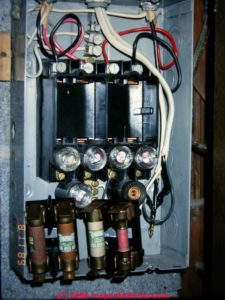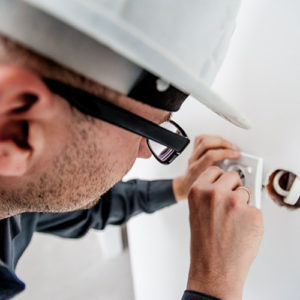12 Jul Problems with Electrical Wiring – ACCL Electrical
Electrical Wiring Problems 101
Do you have an electrical problem that needs to be resolved? Read this article to learn about some of the most frequent electrical issues and how to solve them.
Fuse Boxes

Fuse boxes, such as the one shown above, are less popular than circuit breaker panels these days, but they still operate great – unless someone sets fuses with a higher current than the cables can safely carry. This can cause the wires to overheat, causing damage to their protective insulation and perhaps increasing the risk of fire. Even if the problematic fuse is replaced with one of the right amperage, the hazard remains once the insulation has been damaged. The old circuit must be rewired to address the problem.
Avoiding Hazards with Professional Aid

Some wiring issues are minor annoyances. Others, on the other hand, can cause major fire and electrical concerns. If you’re buying a home (especially one that’s more than 50 years old), or if you’ve never had your wiring evaluated, it’s a good idea to hire a professional electrician to inspect it thoroughly. If the inspection reveals code violations, don’t be concerned. Old wiring is “grandfathered” each time the electrical code is amended, assuming it was put appropriately. Only upgrade wiring in rooms that are being gut-renovated, according to the code.
10 Common Problems
- Over Lamping – The light bulb in a fixture is of a higher wattage than the fixture was designed for.
- Junction Boxes – A person could mistakenly damage the wires or receive a shock since a junction box stores the splices where wires are linked to one another.
- Flickering Exterior Lights – The weatherhead (the external fitting where overhead wires from the electricity line enter the house) has frayed wiring, which causes a short anytime the cables move.
- Not Enough Outlets – Relying on too many extension cords causing falling hazards and open wiring.
- No GFCIS – Electrocution risk is higher in wet places like bathrooms and kitchens. Ground-fault circuit interrupters (GFCIs) shut off circuits in 4 milliseconds, stopping a current from causing a fatal shock.
- Panels – Because too many single-pole breakers (one circuit) have been replaced with tandem breakers (two circuits) in one slot, the panel has more circuits than it is rated to handle. (High-amp double-pole breakers, which take up two slots with one circuit, are not the same as tandem breakers.) Each panel has a label that indicates how many circuits it can accept.
- Aluminum Wiring – You have a type of wire that was utilized as a cheap alternative for copper in the 1960s and 1970s but is no longer deemed safe.
- Backstabbed Wires – Wires pushed in the back of contemporary switches and receptacles are more prone to break loose than those anchored around screw terminals.
- Ungrounded Receptacles – Any stray current that escapes the boundaries of the wires has no way to securely flow through your house’s wiring.
- Loose Plugs – Contacts in the receptacle have worn out and are no longer firmly gripping the prongs.
Solutions:

- Over Lamping – All light fixtures manufactured after 1985 have a wattage limit. Use only 60-watt or smaller bulbs in older, unlabeled fixtures.
- Junction Boxes – Purchase a replacement cover for a few cents and install it using the included screws.
- Flickering Exterior Lights – Contact your electric utility to see if the weatherhead may be replaced for free.
- Not Enough Outlets – Increase the number of outlets. An electrician should charge around $100 per first-floor plug and quadruple that for second-floor work. (There will almost certainly be a minimum fee.) To snake the wires, this job necessitates making holes in walls and ceilings. Some electricians will patch the holes for you, while others will leave it to you.
- No GFCIS – GFCIs (around $12 apiece) should be used to replace old receptacles. This is a basic task that many homeowners can complete on their own. Electricians often charge $20 per outlet. (There will very certainly be a minimum charge.) Note: GFCI breakers ($25) can be installed on the main electrical panel as an alternative. But then you have to walk down to the basement every time one trips to reset it.
- Panels – Replace the old panel with a larger model ($500 to $800) if you’re planning major home modifications, or add a subpanel with a few extra slots ($250).
- Aluminum Wiring – Retrofit each copper/aluminum connection in light fixtures with a dielectric wire nut certified for aluminum wire (a pair costs less than $1). A unique grease has been applied to these nuts to prevent corrosion while retaining conductivity. Ensure that all replacement switches and receptacles are AL-compatible.
- Backstabbed Wires – Remove a switch or receptacle from its outlet box to check for backstabbed connections. There will almost certainly be others if one is backstabbed. Release the wires and connect them to the receptacle’s proper screw terminals.
- Ungrounded Receptacles – If the wiring permits, replace two-prong outlets with appropriately grounded three-prong receptacles. (Also, use a GFCI circuit tester to check that all existing three-prong receptacles are grounded.) Any that aren’t working should be rewired.
- Loose Plugs – As soon as possible, replace the old receptacles. (A new one will set you back roughly $2.) Many homeowners are confident in their ability to complete this task on their own. Electricians will charge $8 to $10 per outlet, with a minimum rate for modest jobs.
Rely on our expert ACCL Electricians:
If you’re worried about any electrical issues and require the aid of a professional, Contact us today for your free estimate!
ACCL Electrical offers repair and replacement services. We would be pleased to develop a guaranteed unique solution to keep your appliances free of obstructions and your electrical needs met be it interior or exterior. We can help. Call 1(905) 448-5909 or visit our contact page to drop us a message http://acclelectrical.ca/contact-us/





No Comments